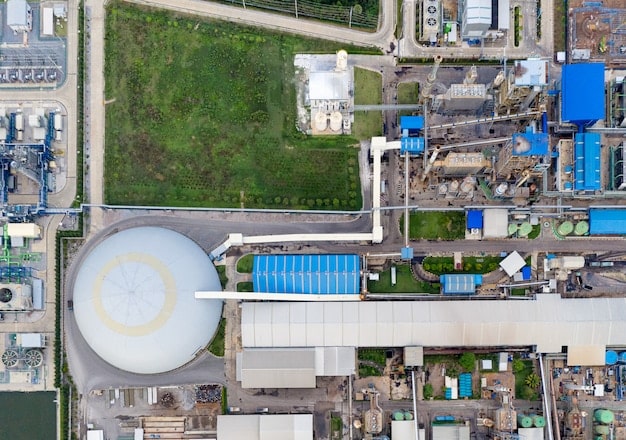Biodiesel & Renewable Diesel Tax Credit: Sustainable Fuel Incentives for 2025

The Biodiesel and Renewable Diesel Tax Credit, a crucial incentive for sustainable fuel production, is set to continue supporting the industry in 2025, encouraging the production and use of biodiesel and renewable diesel across the United States.
The Biodiesel and Renewable Diesel Tax Credit stands as a cornerstone of US energy policy, incentivizing the production and utilization of sustainable fuels and paving the way for a greener future in 2025. As the world increasingly focuses on mitigating climate change, the role of these tax credits becomes even more critical.
Understanding the Biodiesel and Renewable Diesel Tax Credit
The Biodiesel and Renewable Diesel Tax Credit is designed to reduce the cost of producing biodiesel and renewable diesel, making these fuels more competitive with traditional petroleum-based diesel. This incentive supports energy independence, reduces greenhouse gas emissions, and promotes rural economic development.
Enacted to promote alternative fuel sources, the tax credit has undergone several extensions and modifications, reflecting its ongoing importance in the renewable energy landscape. It’s important to understand the intricacies of this credit to fully grasp its impact on the market.
Background and Legislative History
The tax credit, initially introduced as part of the American Jobs Creation Act of 2004, has evolved through numerous legislative actions. It provides a dollar-per-gallon tax credit to eligible biodiesel and renewable diesel producers or blenders. The credit aims to offset the higher production costs associated with these fuels, thereby leveling the playing field with traditional diesel.
Over the years, the credit has faced temporary expirations and subsequent reauthorizations, highlighting the political and economic considerations that influence its continuity.
Key Components of the Tax Credit
- Amount of the Credit: The tax credit offers \$1.00 per gallon for biodiesel and renewable diesel.
- Eligibility Requirements: Producers and blenders who meet specific criteria, including registration with the IRS, can claim the credit.
- Credit Mechanism: The credit is typically claimed when the fuel is either sold or used in a qualifying manner.
The intricacies of eligibility and credit mechanisms are crucial for industry participants to understand and adhere to.
In conclusion, the Biodiesel and Renewable Diesel Tax Credit is a multifaceted incentive designed to stimulate the production and use of sustainable fuels. Its background, legislative history, and key components all play a significant role in shaping its effectiveness and impact.
Impact on Sustainable Fuel Production
The Biodiesel and Renewable Diesel Tax Credit has a profound impact on sustainable fuel production in the United States. By providing financial incentives, the tax credit encourages investment in renewable fuel technologies, stimulates production, and supports job creation.
The increasing demand for cleaner energy sources makes the importance of this tax credit more pronounced. By understanding specific metrics and benefits, one can fully appreciate its role in fostering sustainability.

Increased Production and Capacity
The tax credit directly correlates with increased production volumes of biodiesel and renewable diesel. As producers receive financial benefits for each gallon produced, it incentivizes expanding production capacities.
This surge in production capacity not only meets the growing demands for sustainable fuels but also drives technological innovation in production processes.
Job Creation and Economic Benefits
The sustainable fuel production industry spurred by the tax credit leads to job creation in various sectors, including agriculture, manufacturing, and transportation. Biodiesel and renewable diesel plants create employment opportunities in rural and urban areas alike.
- Agriculture: Increased demand for feedstock crops like soybeans and corn.
- Manufacturing: Jobs in biodiesel and renewable diesel production plants.
- Transportation: Logistics and distribution of sustainable fuels.
These economic benefits ripple through communities, fostering growth and stability.
In summary, the Biodiesel and Renewable Diesel Tax Credit significantly bolsters sustainable fuel production by increasing production capacity, stimulating job creation, and providing overarching economic benefits. These elements work together to foster a sustainable renewable energy industry.
The Landscape of Biodiesel and Renewable Diesel in 2025
As we approach 2025, the landscape of biodiesel and renewable diesel is poised for significant changes. Driven by technological innovations, policy adjustments, and market dynamics, the industry is evolving rapidly.
Understanding the current trends and future projections is essential for stakeholders, policymakers, and industry participants alike.
Technological Advancements
Innovations in feedstock processing, conversion technologies, and fuel optimization are reshaping the biodiesel and renewable diesel sectors. Advancements enable the utilization of a wider range of feedstocks, improve production efficiencies, and enhance fuel quality.
These technological strides are crucial for reducing the environmental impact and improving the economic viability of sustainable fuels.
Policy and Regulatory Updates
Government policies and regulations play a pivotal role in shaping the market for biodiesel and renewable diesel. Changes in tax credits, renewable fuel standards, and environmental regulations can significantly influence production, distribution, and consumption.
- Renewable Fuel Standard (RFS): Mandates blending of renewable fuels into the transportation fuel supply.
- Low Carbon Fuel Standards (LCFS): Encourages the reduction of carbon intensity in fuels.
- Tax Credits: Financial incentives for producers and blenders.
Staying informed about these policy updates is essential for making strategic decisions.

Market Dynamics and Future Projections
The interplay of supply, demand, prices, and consumer preferences shapes the market dynamics for biodiesel and renewable diesel. Factors such as crude oil prices, feedstock availability, and consumer adoption rates influence the market’s trajectory.
Future projections depend on these factors, technological advancements, and the evolving policy landscape; as such, accurate forecasting is vital for industry planning and investment.
In closing, the landscape of biodiesel and renewable diesel in 2025 presents a dynamic picture characterized by technological advancements, policy adjustments, and market dynamics. By staying abreast of these factors, stakeholders can navigate the challenges and seize opportunities in this evolving sector.
Challenges and Opportunities
While the Biodiesel and Renewable Diesel Tax Credit offers numerous benefits, the industry faces notable challenges. Addressing these challenges is crucial for realizing the full potential of sustainable fuels.
Conversely, various opportunities exist to expand the market, improve efficiency, and enhance sustainability.
Feedstock Availability and Sustainability
Ensuring a consistent and sustainable supply of feedstocks is a significant challenge. Reliance on specific crops can lead to concerns about land use, food prices, and environmental impacts.
Diversifying feedstocks and adopting sustainable agricultural practices are vital for mitigating these issues. This involves utilizing non-food crops, waste materials, and algae to produce biodiesel and renewable diesel.
Infrastructure Limitations
Inadequate infrastructure for blending, storing, and distributing biodiesel and renewable diesel can limit market expansion. Upgrading existing infrastructure and investing in new facilities are necessary to accommodate the growing volumes of sustainable fuels.
- Blending Infrastructure: Facilities for blending biodiesel with conventional diesel.
- Storage Facilities: Tanks and terminals for storing sustainable fuels.
- Distribution Networks: Pipelines, trucks, and railcars for transporting fuel.
Improvements in infrastructure can facilitate more efficient distribution and wider market penetration.
Market Expansion and Consumer Adoption
Expanding the market for biodiesel and renewable diesel requires raising awareness among consumers and overcoming barriers to adoption. Many consumers are unaware of the benefits of sustainable fuels or are hesitant to switch due to concerns about performance or compatibility.
Educating consumers, addressing concerns, and incentivizing the use of sustainable fuels can increase adoption rates and achieve broader market expansion.
To summarize, the Biodiesel and Renewable Diesel Tax Credit faces challenges related to feedstock availability, infrastructure limitations, and market expansion. Overcoming these obstacles while capitalizing on opportunities can drive the sustainable fuel industry towards a more resilient and prosperous future.
Policy Recommendations for 2025 and Beyond
To maximize the effectiveness of the Biodiesel and Renewable Diesel Tax Credit, policymakers should consider adopting specific recommendations for 2025 and beyond. These recommendations aim to address existing challenges, capitalize on opportunities, and foster a more sustainable and resilient industry.
By implementing these policies, the United States can solidify its position as a leader in renewable energy and drive advancements in sustainable fuel production.
Long-Term Extension of the Tax Credit
Providing certainty to producers and investors is achieved through a long-term extension of the Biodiesel and Renewable Diesel Tax Credit. Uncertainty about the credit’s future can deter investment and hinder long-term planning.
A multi-year extension would provide stability, encourage innovation, and support sustained growth in the industry.
Expansion of Eligible Feedstocks
Expanding the range of eligible feedstocks for the tax credit would promote diversification and sustainability. Including non-food crops, waste materials, and algae can reduce reliance on traditional agricultural crops and minimize environmental impacts.
- Non-Food Crops: Utilizing crops specifically grown for biofuel production.
- Waste Materials: Converting waste oils and fats into sustainable fuels.
- Algae: Cultivating algae for biodiesel and renewable diesel production.
Such inclusive strategies encourage innovation and enhance the sustainability of the industry.
Infrastructure Development Incentives
Offering incentives for infrastructure development would facilitate blending, storage, and distribution of biodiesel and renewable diesel. These incentives could include tax credits, grants, and loan guarantees for upgrading existing facilities and constructing new ones.
Such investments in infrastructure are critical for accommodating increased production volumes and enabling wider market penetration.
In conclusion, policy recommendations for 2025 and beyond should focus on long-term extensions of the tax credit, expansion of eligible feedstocks, and infrastructure development incentives. Implementing these policies will foster a more sustainable, resilient, and prosperous biodiesel and renewable diesel industry.
Conclusion
In summary, the Biodiesel and Renewable Diesel Tax Credit remains a crucial incentive for fostering sustainable fuel production in 2025 and beyond. It continues to demonstrate a significant impact on increasing renewable fuel volumes, bolstering job creation, and contributing to broader energy independence. By addressing existing challenges, adjusting policies, and seizing emerging opportunities, stakeholders can ensure the tax credit remains effective in driving the industry toward a greener future.
| Key Point | Brief Description |
|---|---|
| 🌱 Tax Credit Impact | Incentivizes sustainable fuel production and reduces emissions. |
| 🏭 Production Boost | Stimulates increased production volumes of biodiesel and renewable diesel. |
| 💼 Economic Benefits | Creates jobs in agriculture, manufacturing, and transportation sectors. |
| 🌐 Policy Support | Provides financial stability and encourages long-term investments. |
FAQ
▼
The Biodiesel and Renewable Diesel Tax Credit is a \$1.00 per gallon incentive for biodiesel and renewable diesel production designed to lower the financial burden, enhancing competition with traditional fuel. It also encourages sustainable fuel sources.
▼
Eligible parties typically include biodiesel and renewable diesel producers and blenders registered with the IRS. They must meet certain criteria to qualify for the credit, which contributes to the sector’s oversight.
▼
The tax credit fosters job creation across agriculture, manufacturing, and transportation. It supports facilities and infrastructure that need staffing throughout production and distribution, thus boosting economic prosperity.
▼
The future for these renewable fuels looks promising, driven by tech advancements, policy support, and rising market demand. Efficient processing methods and government incentives are expected to push future growth.
▼
To improve effectiveness, policy changes such as extending the credit duration and expanding eligible feedstocks can be made. These adjustments can bolster the initiative and guarantee the industry’s sustainability.
Conclusion
The Biodiesel and Renewable Diesel Tax Credit stands as a critical component in promoting sustainable fuel production. By providing financial incentives, this tax credit not only encourages the production and use of biodiesel and renewable diesel but also supports economic growth and reduces greenhouse gas emissions. Continuous policy refinement and industry adaptation will be essential to achieve long-term sustainability goals.





